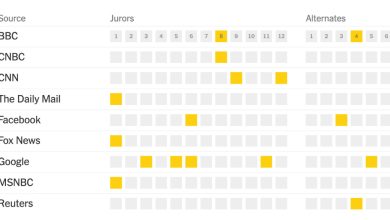In the Fight Over How to Teach Reading, This Guru Makes a Major Retreat

For decades, Lucy Calkins has determined how millions of children learn to read. An education professor, she has been a pre-eminent leader of “balanced literacy,” a loosely defined teaching philosophy.
In a classic Calkins classroom, teachers read aloud from children’s literature; students then chose “just right” books, which fit their interests and ability. The focus was more on stories — theme, character, plot — less on sounding out words.
Her curriculum, “Units of Study,” is built on a vision of children as natural readers, and it has been wildly popular and profitable. She estimates that a quarter of the country’s 67,000 elementary schools use it. At Columbia University’s Teachers College, she and her team have trained hundreds of thousands of educators.
But in recent years, parents and educators who champion the “science of reading” have fiercely criticized Professor Calkins and other supporters of balanced literacy. They cite a half-century of research that shows phonics — sound it out exercises that are purposefully sequenced — is the most effective way to teach reading, along with books that build vocabulary and depth.
With brain science steadily adding to that evidence, there is a sense — at least for many in the education establishment — that the debate over early reading instruction may be ebbing. Phonics is ascendant.
More than a dozen states have passed laws pushing phonics, and Denver and Oakland, Calif., have moved to drop Professor Calkins’s program. In one of her largest markets, New York City, a dyslexic mayor and his schools chancellor are urging principals to select other curriculums.
So after decades of resistance, Professor Calkins has made a major retreat. A rewrite of her reading curriculum, from kindergarten to second grade, includes, for the first time, daily structured phonics lessons to be used with the whole class. There are special books and assessments to track students’ progress with decoding letters.
And it swaps light reading assignments for more rigorous texts: arctic exploration, female deep sea divers in South Korea, the architecture and culture of Islam.
The curriculum, which goes on sale this summer, also includes a 20-page guide for teachers summarizing 50 years of cognitive research on reading.
“All of us are imperfect,” she said in an interview at her office, perched above Columbia’s campus. “The last two or three years, what I’ve learned from the science of reading work has been transformational.”
It may not inspire political campaign ads the way critical race theory does, but the debate over how to teach children to read —perhaps the foundational skill of all schooling — has been just as consuming for some parents, educators and policymakers. Through decades, classroom practice has lurched back and forth, with phonics going in and out of style.
Margaret Goldberg, a Bay Area literacy coach and leader in the science of reading movement, said Professor Calkins’s changes cannot repair the harm done to generations of students. Even before the pandemic widened educational inequality, only one-third of American fourth and eighth graders were reading on grade level. Black, Hispanic and low-income children have struggled most.
“So many teachers like me have believed that a professor at Teachers College, an Ivy League institution, should be up-to-date on the reading research,” she said. “The fact that she was disconnected from that research is evidence of the problem.”
How Professor Calkins ended up influencing tens of millions of children is, in one sense, the story of education in America. Unlike many developed countries, the United States lacks a national curriculum or teacher-training standards. Local policies change constantly, as governors, school boards, mayors and superintendents flow in and out of jobs.
Amid this churn, a single charismatic thinker, backed by universities and publishing houses, can wield massive power over how and what children learn.
Myth of the Natural Reader
Some children seem to turn magically into readers, without deliberate phonics coaching. That has helped fuel a mistaken belief that reading is as natural as speaking. In fact, functional magnetic resonance imaging of the brain demonstrates that humans process written language letter by letter, sound by sound. Far from being automatic, reading requires a rewiring of the brain, which is primed by evolution to recognize faces, not words.
But that finding — by cognitive psychologists and neuroscientists — is often disconnected from the work of training teachers and producing classroom materials.
Indeed, Professor Calkins, 70, is far more typical in the world of curriculum development: She is a teacher, a writer and a theorist.
After several years teaching in her 20s, she entered academia in the late-1970s, part of a circle of thinkers developing the process-oriented approach to teaching writing. Intended for adults, it emphasizes keeping a journal to find one’s voice, receiving feedback from peers and revising drafts.
Professor Calkins became a revolutionary leader in education by bringing these practices to young children at a time when penmanship, spelling and sentence structure were often a bigger focus. At Teachers College, she began training educators in New York City schools, prompting them to give children “writers’ notebooks” to chronicle their lives. For many students, her method was empowering, although critics have said it was too loose for those without strong grammatical skills.
Still, Professor Calkins and her team were widely lauded for offering teachers respect and support. At workshops on Columbia’s idyllic campus, educators were encouraged to see themselves and their students as intellectuals. Eventually, a vibrant online community developed.
Professor Calkins expanded into reading instruction, using similar principles. A goal was on helping children to build a joyful identity as a reader. Even then, she said she never doubted the importance of phonics. In sample classroom schedules, she told schools to set aside time for it.
But her influential 2001 book, “The Art of Teaching Reading,” warned about what she saw as the risks of too much sounding-it-out. She praised one teacher for avoiding “an intricate series of activities with phonics,” and argued that a simple way to build “lifelong readers” was to allow children to spend time with books they chose, regardless of content or difficulty.
For children stuck on a difficult word, Professor Calkins said little about sounding-out and recommended a word-guessing method, sometimes called three-cueing. This practice is one of the most controversial legacies of balanced literacy. It directs children’s attention away from the only reliable source of information for reading a word: letters.
Three-cueing is embedded in schools. Online, novice teachers can view thousands of how-to guides. In a 2020 video, a teacher tells children to use a picture to guess the word “car,” even though simple phonics make it decodable.
Professor Calkins said word-guessing would not be included in her revised curriculum. But in some ways, she is offering a hybrid of her old and new methods. In a sample of the new materials that she provided to The Times, teachers are told that students should first decode words using “slider power” — running their fingers under letters and sounding them out — but then check for mistakes using “picture power.”
Mark Seidenberg, a cognitive neuroscientist at the University of Wisconsin, Madison, said that while he found some of the revisions “encouraging,” he was concerned that “objectionable” concepts remain.
There is little controlled research of her methods, and two recent studies come to conflicting conclusions: One, funded by Teachers College and Professor Calkins’s publisher but conducted independently, found students in her network outperform others on reading tests. Another saw no statistically significant improvements.
Some parents say no revision from Professor Calkins could earn their trust.
Diane Dragan, a mother of three dyslexic children, aged 9 to 14, has spent years pushing the Lindbergh school district in St. Louisto drop the Units of Study. She said she paid $4,500 a month for intensive tutoring, to help her children catch up on foundational skills overlooked by the curriculum.
When children don’t learn to read, she said, “They doubt their ability to do anything in life.”
When Professor Calkins was asked what changed her mind about the science of reading, she cited, without defensiveness, several experts who have criticized her work: Professor Seidenberg, author of the influential book “Language at the Speed of Sight,” and Emily Hanford, a journalist who has investigated the shortcomings of reading instruction.
She said studying learning disabilities like dyslexia also led her to accept that all children would benefit from more structured phonics.
“Dyslexia is a spectrum,” she said.
Margaret Goldberg, the literacy coach, said Professor Calkins should offer a fuller statement of regret — and send a correction to schools using her old materials.
Professor Calkins does not believe she has anything to apologize for. She pointed out that some partner schools, like P.S. 249, a high-poverty, high-performing school in Brooklyn, have embraced a separate phonics supplement she published in 2018.
And, she asked, shouldn’t the phonics-first camp apologize? “Are people asking whether they’re going to apologize for overlooking writing?” she said.
Teachers College said in a statement that among its faculty, there was no disconnect across subjects like cognitive research, curriculum development and teacher preparation. Elementary educators and literacy specialists are required to take courses, it said, that “engage with science of reading concepts such as sequenced, research-based instruction in phonics and language patterns, phonetic reading and linguistic structures.”
The Finances
Professor Calkins has described the organization she founded in 1981, the Teachers College Reading and Writing Project, as a “not-for-profit think tank.” But the project is also a business, encompassing domestic and international companies. It provides training to some 700 schools across the United States and in countries like Japan, Jordan, Spain, Singapore and Brazil.
According to a 2016 contract between New York City and Teachers College, schools paid up to $2,650 for a seven-hour visit from a consultant with Professor Calkins’s group and were encouraged to purchase 20 visits a year.
In reality, Professor Calkins said, most schools paid less. In total, the district paid $31 million between 2016 and 2022 for services from the Teachers College Reading and Writing Project.
The project has about 165 partner schools across the city, which may now be under pressure to reconsider the program.
“Lucy Calkins’s work, if you will, has not been as impactful as we had expected,” the schools chancellor, David C. Banks, said in March.
Teachers College would not detail its revenue from Professor Calkins’s activities but said her contribution to its bottom line was “modest.” A review of school contracts across the country showed that much of Professor Calkins’s work outside New York City was funneled through her businesses. That structure, she said, allowed her to pay competitive salaries to her 75-person staff. She and her co-authors also earn royalties for her books, published by Heinemann, a division of Houghton Mifflin Harcourt.
Heinemann declined to share sales figures for the Units of Study. But schools that purchased the old curriculum within the last three years can fully deduct that cost from the list price of the revised units, which would mean they would spend $186 per classroom.
That deal, Professor Calkins said, will allow schools to afford her more science-based approach. Her organization will also push the new methods at training sessions, which are a significant expenditure for schools. Purchasing student books that accompany the curriculum costs hundreds to thousands of dollars more.
“Certainly, I am not about the money of this,” Professor Calkins said. “We’re trying to get the word out as best we possibly can.”
Classroom practice is notoriously slow to evolve, even with revised curriculum. And some of Professor Calkins’s methods are sure to remain divisive. She still believes in peer collaboration during phonics lessons, and in silent reading for kindergartners who are primarily looking at pictures. Critics see those activities as a waste of precious classroom minutes.
But because Professor Calkins has been so trusted by educators, her shift on the science of reading could drive real change, despite what some see as a long delay.
The question for Professor Calkins and schools nationwide is whether her new curriculum will show better results for students. Research points to a broad set of skills necessary to become a literate person — including phonics, vocabulary and knowledge of current events, history, art, sports and nature.
The stakes are high, said Tracy White Weeden, president of the Neuhaus Education Center, a nonprofit that trains educators in reading strategies.
“We have schools,” she said, “that have not benefited from understanding how to do the most important thing we do — ensure students leave literate.”
Kirsten Noyes contributed research.



